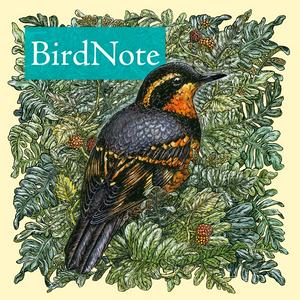1302 episoder

Building Birds with LEGO
20.12.2025 | 1 min.
Thomas Poulsom is a hobbyist LEGO builder best known for his models of birds. But making birds out of bricks isn't easy. That’s why he uses special pieces to sculpt something entirely different — like when minifigure carrots became a puffin’s legs. A unique piece called a “snot brick” allows him to build in any direction, making it possible to make a round object out of square LEGO bricks.More info and transcript at BirdNote.org.Want more BirdNote? Subscribe to our weekly newsletter. Sign up for BirdNote+ to get ad-free listening and other perks. BirdNote is a nonprofit. Your tax-deductible gift makes these shows possible. Hosted by Simplecast, an AdsWizz company. See pcm.adswizz.com for information about our collection and use of personal data for advertising.

Painting Birdsong with Jane Kim
19.12.2025 | 1 min.
At the visitor center of the Cornell Lab of Ornithology, artist and scientific illustrator Jane Kim painted the Wall of Birds to celebrate the evolution and diversity of birds. Completed in December 2015, the massive mural depicts nearly 250 birds — and several of their ancient predecessors — on a map of the world where each lives. Jane worked closely with scientific advisors to ensure that each portrait accurately represents the bird's features and behaviors, including many species — like the Three-wattled Bellbird — that appear to sing from their place on the wall.Read more about Jane Kim in Field Notes!More info and transcript at BirdNote.org.Want more BirdNote? Subscribe to our weekly newsletter. Sign up for BirdNote+ to get ad-free listening and other perks. BirdNote is a nonprofit. Your tax-deductible gift makes these shows possible. Hosted by Simplecast, an AdsWizz company. See pcm.adswizz.com for information about our collection and use of personal data for advertising.

Dining with Sanderlings
18.12.2025 | 1 min.
While many shorebirds have gone south, tiny sandpipers called Sanderlings are easy to find on winter shores. They follow the waves as they lap in and out, probing the swirling sand for prey. They often eat various small crustaceans such as mole crabs, isopods, and amphipods. But they also enjoy miniature clams, polychaete worms, and horseshoe crab eggs. They’ll even catch flying insects or eat plant matter.This episode is dedicated to Deb Rivel, for her many years of board service and generous support of BirdNote.More info and transcript at BirdNote.org.Want more BirdNote? Subscribe to our weekly newsletter. Sign up for BirdNote+ to get ad-free listening and other perks. BirdNote is a nonprofit. Your tax-deductible gift makes these shows possible. Hosted by Simplecast, an AdsWizz company. See pcm.adswizz.com for information about our collection and use of personal data for advertising.

Kittiwake, Kittiwake
17.12.2025 | 1 min.
Named for its rhythmic calls, the Black-legged Kittiwake is a dapper, oceanic gull. As described by Roger Tory Peterson, the tips of its pale gray wings "are cut straight across, as if they had been dipped in ink." Unlike many gulls, kittiwakes spend most of the year at sea and are seldom seen inland.More info and transcript at BirdNote.org.Want more BirdNote? Subscribe to our weekly newsletter. Sign up for BirdNote+ to get ad-free listening and other perks. BirdNote is a nonprofit. Your tax-deductible gift makes these shows possible. Hosted by Simplecast, an AdsWizz company. See pcm.adswizz.com for information about our collection and use of personal data for advertising.

Andean Condors Sail the Wind
16.12.2025 | 1 min.
The Andean Condor is one of the largest flying birds in the world. With a wingspan that can stretch over 10 feet across, the condor doesn’t flap so much as sail, using rising thermals to glide across the Andes for hours. Once revered in Inca mythology as a messenger of the gods, the Andean Condor now graces the coat of arms of Bolivia, Chile, Colombia, and Ecuador. But like many scavengers, condor populations are declining due to threats like lead poisoning and habitat loss.More info and transcript at BirdNote.org.Want more BirdNote? Subscribe to our weekly newsletter. Sign up for BirdNote+ to get ad-free listening and other perks. BirdNote is a nonprofit. Your tax-deductible gift makes these shows possible. Hosted by Simplecast, an AdsWizz company. See pcm.adswizz.com for information about our collection and use of personal data for advertising.
Flere Uddannelse podcasts
Trendige Uddannelse podcasts
Om BirdNote Daily
Lyt til BirdNote Daily, Ramt Af Stjernerne og mange andre podcasts fra hele verden med radio.dk-appen

Hent den gratis radio.dk-app
- Bogmærke stationer og podcasts
- Stream via Wi-Fi eller Bluetooth
- Understøtter Carplay & Android Auto
- Mange andre app-funktioner
Hent den gratis radio.dk-app
- Bogmærke stationer og podcasts
- Stream via Wi-Fi eller Bluetooth
- Understøtter Carplay & Android Auto
- Mange andre app-funktioner


BirdNote Daily
download appen,
begynd at lytte.